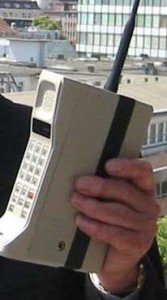I finally broke down and got an iPhone a year ago. I carry it when I’m out and about, but most of the time it sits on the kitchen counter. Some days I don’t use it all because my retirement lifestyle doesn’t require much instantaneous communication.
I’ve been using cell phones almost since they were invented. When I was working for Illinois Bell in Chicago, I handled publicity for the first customer trial of cell phones in 1978. Those phones were permanently installed in cars with a suitcase-sized electronics package in the trunk and twin antennas on the roof. They cost thousands of dollars but were quickly snapped up by busy business folks.
During the trial I participated in an informal brainstorming session to suggest a name for the new service. “Bell on wheels” and “ring-a-ding-along” were quickly rejected. AT&T decided to call it Advanced Mobile Phone Service, or AMPS: the kind of name you night expect from a company dominated by engineers. The name did not stick.
Full commercial service did not start until 1982 because it took longer for the Federal Communications Commission to allocate frequencies and figure out how to regulate the service than for Bell Laboratories and Motorola to develop the technology. (Yes, that’s the same agency that now intends to regulate the Internet.)
 As a telephone company guy, I occasionally used cell phones at work. The first portable model, which we called the “boat anchor,” had a battery pack about the size and weight of a bowling ball. Then came the handset-on-steroids “brick.” “Hey, your briefcase is ringing,” someone told me.
As a telephone company guy, I occasionally used cell phones at work. The first portable model, which we called the “boat anchor,” had a battery pack about the size and weight of a bowling ball. Then came the handset-on-steroids “brick.” “Hey, your briefcase is ringing,” someone told me.
The convenience of carrying a phone was a big deal in those days. My work often required me to keep in touch with the office and made me a frequent user of pay phones and pagers — both of which have practically disappeared. I still make it a point to stay reachable by forwarding calls from my home phone to my cell whenever I go out.
Apart from business calls, I was never a heavy cell phone user. I used to marvel at the folks who seemed to spend most of their time shouting into their phones (in the supermarket checkout line) in the days when a lengthy cell phone call was a ten-dollar holler. I’m just as puzzled by people who walk into light poles while gazing down at their smartphones. One of my pet peeves at the gym is people who get engrossed in their phones while occupying the Nautilus machine I’m waiting for. I leave my phone in my locker.
In 1992, about the time cell phones became widespread, a personal-injury lawyer introduced the theory that cell phones cause brain cancer. Since then, scores of studies have failed to establish a link between phone usage and cancer, but alarmists and lawyers remain hopeful. If cell phones really did cause cancer, thousands of the most annoying phone addicts would have removed themselves from the gene pool by now. We should be so lucky. Brain cancer fear should become a non-issue as text messages outstrip voice calls, but may be replaced by some sort of carpal-thumb syndrome.
Early cell phones came with a stern warning to not use the phone while driving — which was universally ignored and quickly dropped. Laws prohibiting driving with handheld phones have not fared much better. I may be the only person in Albuquerque who uses a Bluetooth headset behind the wheel.
Cell phones were second phones for most people in the 1980s and 90s because dropped calls and poor voice quality were common. That’s changed as cell phone service has improved and landline/cable service has deteriorated. I now use my iPhone, rather than my home phone, for conference calls and eventually may scrap the home phone entirely.
I don’t communicate much with my iPhone but like having my contact list, calendar, email and photos synchronized with my iPad and Mac. I used a smartphone app to navigate the subway system on a recent visit to Washington, DC. Other apps lead me back to where I parked my car, help me calculate the tip in a restaurant and check prices at nearby gas stations. iPhone apps promise to be even more useful as senior moments occupy more of my waking hours.
